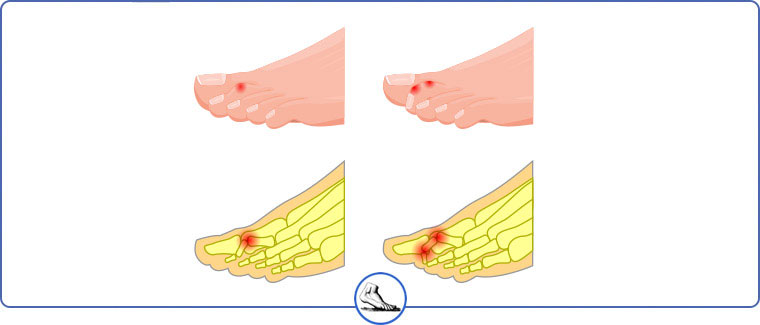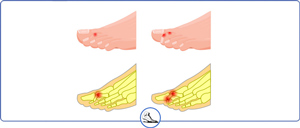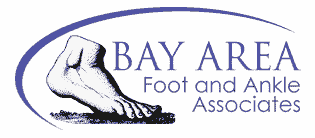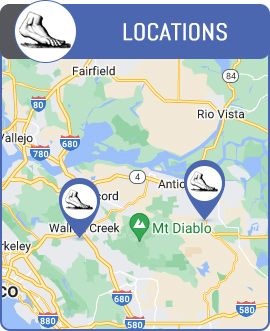Hammertoe Treatment Specialist Q&A
Hammertoe is a deformity that causes your toe to bend or curl downward instead of pointing forward. This can affect any toe on your foot, but it most often affects the second or third toe. If you are suffering from an uncomfortable hammertoe, it’s time to see Dr. John W. Scivally, DPM, and Dr. Robin K. Lie, DPM, and correct it before it progresses any further. Hammertoe treatment is available at Bay Area Foot and Ankle Associates. For more information, contact us or schedule an appointment online. We have convenient locations to serve you in Walnut Creek, and Brentwood, CA.


Table of Contents:
What is Hammertoe?
What are Common Symptoms of a Hammertoe?
How Does A Hammertoe Develop?
How Do We Diagnose and Treat A Hammertoe?
Hammertoe is a deformity in the first joint (proximal interphalangeal joint) of the toe that causes it to bend or curl downwards. This condition develops when the muscles, tendons, and ligaments surrounding the toe go out of balance, putting pressure on the toe to become permanently bent. Hammertoe can happen at the time of birth, when the toes of some babies curl inward. However, it is more commonly a result of physical stress placed on the toes or chronic health problems in the feet. Any of the toes can be affected, but it occurs most frequently in the second and fifth toes. Two categories of hammertoe exist:
• Flexible Hammertoe: This is the stage at which it is still possible to move the distorted toe joint
• Rigid Hammertoe: is a more serious state where the joint is stiff and often results from leaving the flexible hammertoe untreated or in cases of advanced arthritis
The most obvious sign of hammertoe is the physical appearance of a downward pointed V-shaped bend in the toe’s first joint. It is characterized by pain, rigidity, and difficulty with mobility in the hammertoe. Because of the protrusion caused by the bend, the toe is more predisposed to develop blisters, corns, and calluses due to the increased contact and rubbing action that takes place between the deformed toe and the shoe during movement. The ball of the foot can also be impacted, and pain can develop from calluses and blisters due to an imbalance between the ball of the foot and the deformed toes. Further pain, swelling and redness can occur from walking and other forms of physical activity, involving the use of the feet and toes. Over time, walking and other forms of movement can become increasingly more difficult.
A primary cause of hammertoe is wearing tight or ill-fitting shoes that can lead to muscle imbalance in the toes. Formation of bunions is often a secondary consequence of this and pushes the toes together, distorting their joints. High-heeled shoes can exacerbate the condition by also constricting the toes leading to unnatural bending of the toe joints. If this occurs over long periods, it can become a permanent condition. Naturally, women are more susceptible to conditions that can result in a hammertoe. Traumatic injury to the joint of the toe, when it is stubbed or broken, can also give rise to permanently bent toe joints. Another major factor influencing the formation of hammertoe is the presence of chronic health issues, principally arthritis, and diabetes, which affect the joints directly or through complications, as is the case with the latter condition. Age, genetic predisposition, or even a longer second toe bone and high arches in the foot are further determinants influencing the development of hammertoes.
Diagnosis is first made by physical examination of the foot, along with a review of the patient’s medical history, including their symptoms. An x-ray can provide more information on the stage of deformity of the hammertoe. For flexible hammertoes, interventions such as wearing properly fitting shoes with custom supporting insoles or padding in areas where rubbing occurs would be initial steps. Reducing corns and calluses with over-the-counter healing pads and medications are remedies that can reduce pain and inflammation. Wearing a splint or securing the toe with tape may be other recommendations that can be made by your healthcare practitioner. Non-steroidal anti-inflammatories can also be prescribed for pain management. However, surgical intervention may be necessary for more severe and advanced cases of hammertoe. Bunions may require surgical removal if over-the-counter measures do not lead to adequate improvements. Outpatient and office-based surgical procedures can be performed to alter the toe bones, tendons, and joints to correct the deformity and improve patient mobility. Stretching and movement of the affected toes can help maintain correction of the toe after surgery. For more information, contact us or schedule an appointment online. We have convenient locations to serve you in Walnut Creek, and Brentwood, CA. We serve patients from Walnut Creek CA, Brentwood CA, Concord CA, Pleasant Hill CA, Pittsburg CA, Antioch CA, Alamo CA, Danville CA, Oakley CA, and surrounding areas.

Additional Services You May Need
▸Custom Foot Orthotics
▸Ingrown Toenail Specialist
▸Traditional Podiatry Care
▸Foot and Ankle Surgery Clinic
▸Bunion Doctor
▸Corns and Calluses
▸Foot Arthritis and Joint
▸Warts
▸Video Gait Analysis
▸Athletic Taping
▸Pediatric Foot Specialist
▸Gait Abnormalities
▸Foot Dermatologist
▸Foot Deformities
▸Chronic Foot Injury
▸Diabetic Foot Specialist
▸Acute Foot Injuries
▸Podiatric Sports Services
▸Plantar Fasciitis Specialists


